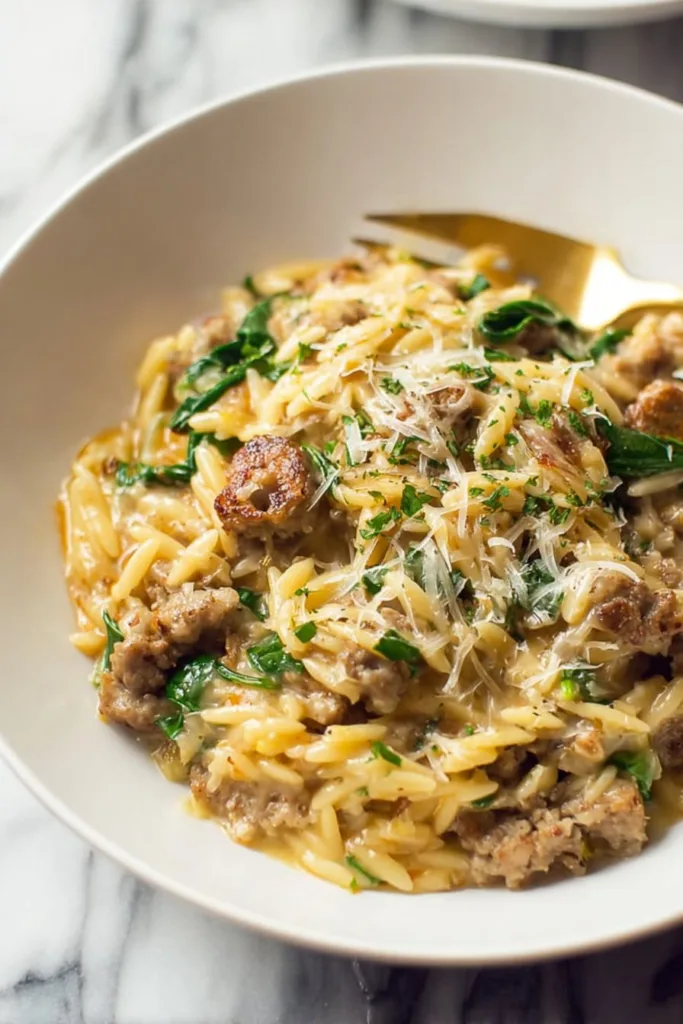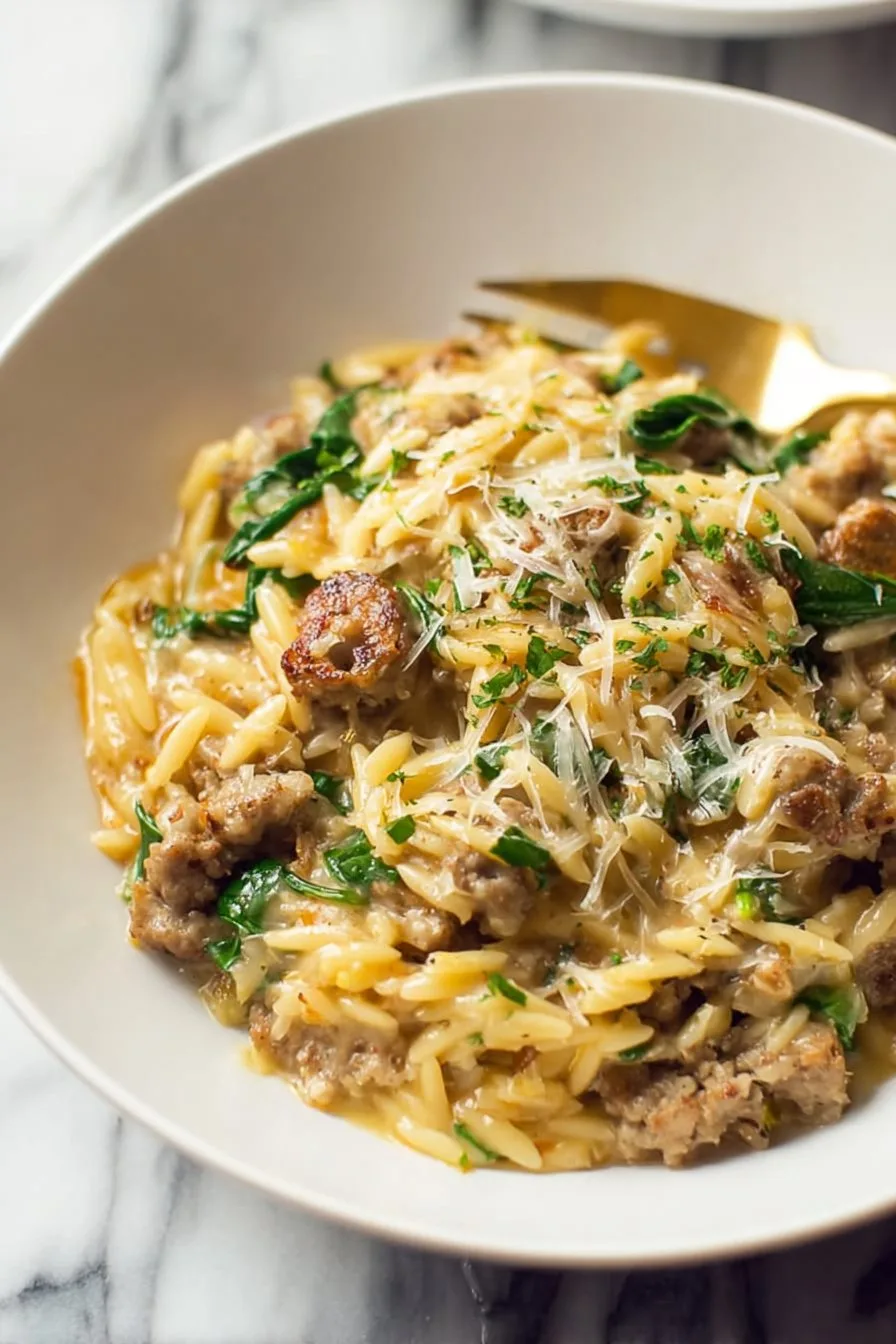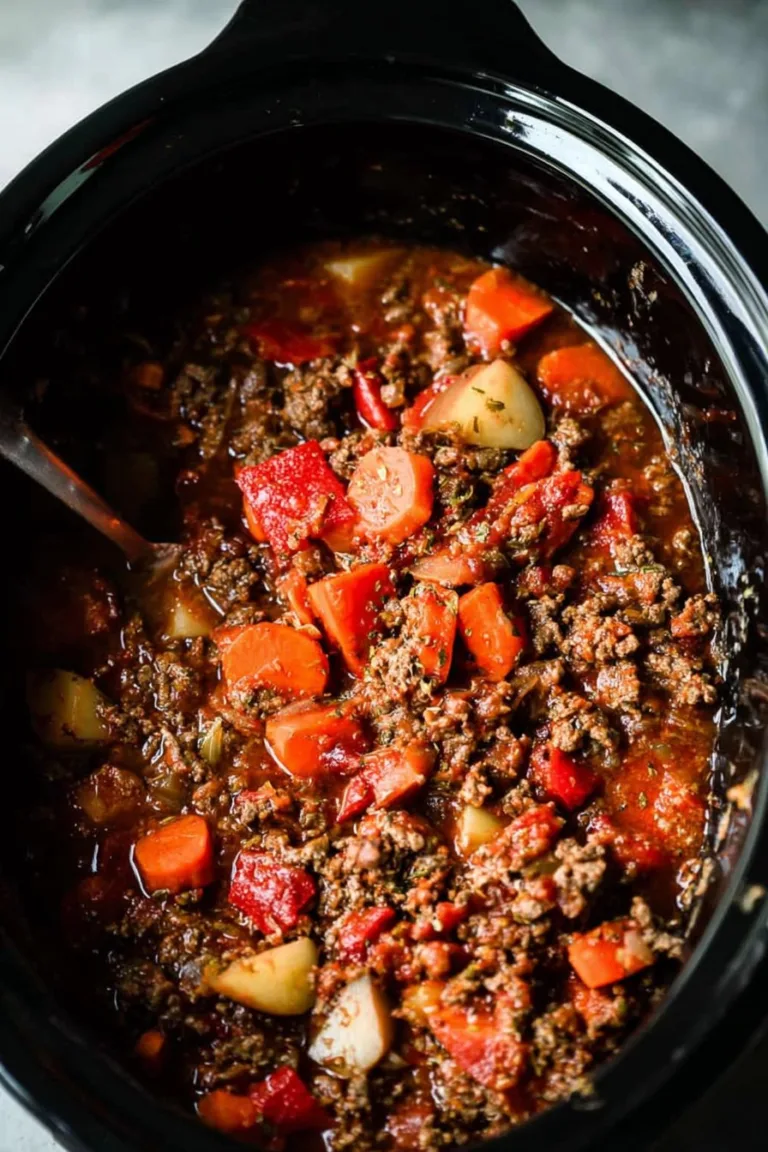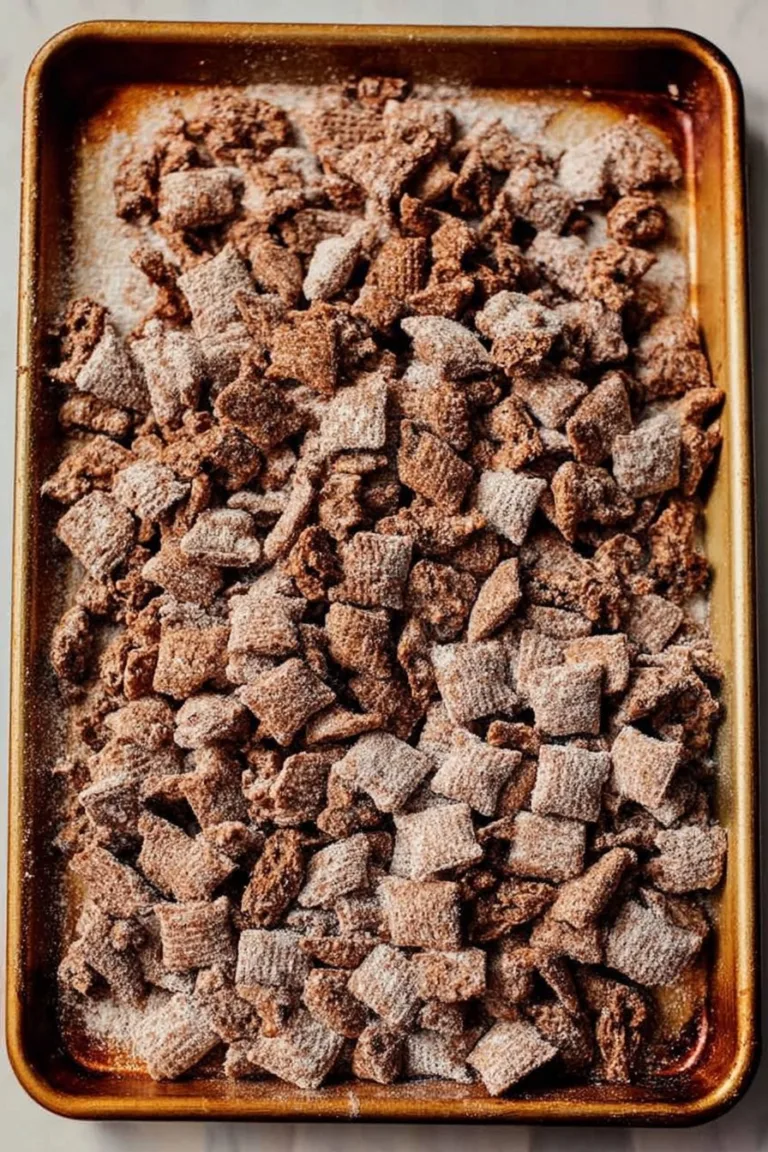Let Me Tell You About This Italian Sausage Orzo…
So, picture this: it’s one of those evenings where everyone in the house is hungry (and somehow, it’s always at the same time), but honestly, I’m running on fumes. That’s when I go to my old standby—Italian Sausage Orzo. The first time I made it, I was actually trying to use up a random pack of sausage and a half-bag of orzo I found at the back of the pantry (always a risky game). To my amazement, it turned out not just edible, but actually something my family now demands on a semi-regular basis. It’s warm, it’s satisfying, and, well, it kinda tastes like you’re cheating at making risotto, which I’m all for.
And yes, there’s usually a glass of wine nearby—sometimes in the food, sometimes in me. You know how it goes.
Why You’ll Probably Love This (Honestly)
I make this when I want something quick but still feels a little fancy (but not, like, “company’s coming” fancy). My family goes absolutely bananas for it because the sausage packs a wallop of flavor, and the orzo gets all creamy and cozy (I mean, who wouldn’t want a hug in a bowl after a long day?).
One thing though—sometimes the orzo sticks a bit to the bottom of the pot if you forget to stir. But that’s nothing a little elbow grease can’t fix, right? I used to think you had to use fancy sausage, but honestly, pretty much any will do. (I tried chicken sausage once; it was… okay-ish, but pork is king here.)
What You’ll Need (And What You Can Totally Swap)
- Italian sausage (about 400g/14oz): Hot, mild, or whatever you’ve got. I usually just grab whatever’s on sale. My grandmother swore by Johnsonville, but let’s be real, store brand works fine too.
- Orzo pasta (250g or about 1 heaping cup): If you can’t find orzo, small pasta shapes like ditalini work—I’ve even used broken-up spaghetti in a pinch.
- 1 onion, diced: Yellow or white, doesn’t matter. Red works but makes it a bit sweet, which I kind of like.
- 2-3 cloves garlic, minced: Or more, but I once put in a whole head and, let’s just say, no vampires for miles.
- 1 can diced tomatoes (400g/14oz): You can also use fresh tomatoes (about 3 big ones), but that takes more effort than I usually have on a weeknight.
- 2 cups chicken broth: Homemade is nice, but I’m not above bouillon cubes.
- 1/2 cup grated Parmesan cheese: The pre-grated stuff is fine. (Don’t tell the food snobs.)
- A handful of fresh basil (or a teaspoon dried): Parsley works, too.
- Olive oil, salt, pepper: To taste. And a pinch of chili flakes if you like a kick.
How I Usually Throw It Together (More or Less)
- First, heat a large skillet or Dutch oven (if you don’t have one, honestly any big pan will do, just be ready for some spillage) over medium heat. Splash in some olive oil.
- Squeeze the sausage out of its casing and crumble into the pan. Brown it up, breaking it apart as you go—aim for golden bits. If there’s a lot of grease, I drain some off, but a little fat = flavor.
- Toss in the onion (and garlic after the onion’s softened a bit, so you don’t burn it). Stir everything around until it smells fantastic. This is usually when my kids come wandering into the kitchen.
- Stir in the orzo and let it toast for a minute—don’t skip this, it adds a lot. Though, I’ve forgotten before, and it still turned out just fine, so no need to stress.
- Pour in the tomatoes (juice and all), then the broth. Give it all a good stir, then bring to a gentle simmer.
- Let it bubble away, uncovered, for about 10-12 minutes. Stir every so often so nothing sticks (or at least not too much—I always get a bit anyway).
- Once the orzo’s tender and most of the liquid’s gone, take it off the heat. Stir in the Parmesan and basil. Taste for salt and pepper. (This is universally known as the best part: the “official taste test.”)
- That’s it! If it’s too thick, add a splash more broth. Too soupy? Let it cook another minute. See? Easy.
Notes from the School of Hard Knocks
- If your orzo goes a bit mushy, join the club. Actually, I think it tastes even better the next day when it’s extra creamy. (If it survives that long.)
- I’ve tried making this with whole wheat orzo, but the texture gets…weird. Maybe that’s just me.
- Don’t panic if you forget the herbs. It’s still good, just less “Instagram-worthy.”
What Else I’ve Tried (Some Hits, Some Misses)
- Used spicy sausage with a splash of cream at the end—chef’s kiss.
- Tossed in spinach in the last minute for something green. It wilts in like magic.
- I once tried adding zucchini. Nope. The texture threw me for a loop, but maybe you’ll like it?
- Subbed Parmesan with feta once (ran out), and it was surprisingly tasty.
What You Need to Make It (Or Not…)
- Big skillet or Dutch oven: But honestly, I’ve made it in a regular saucepan. Just stir a little more, and watch for boil-overs. A wooden spoon is classic, but I’ve used a spatula, a ladle, even a salad fork (don’t judge).
- Measuring cups: Or just use a mug. Close enough.
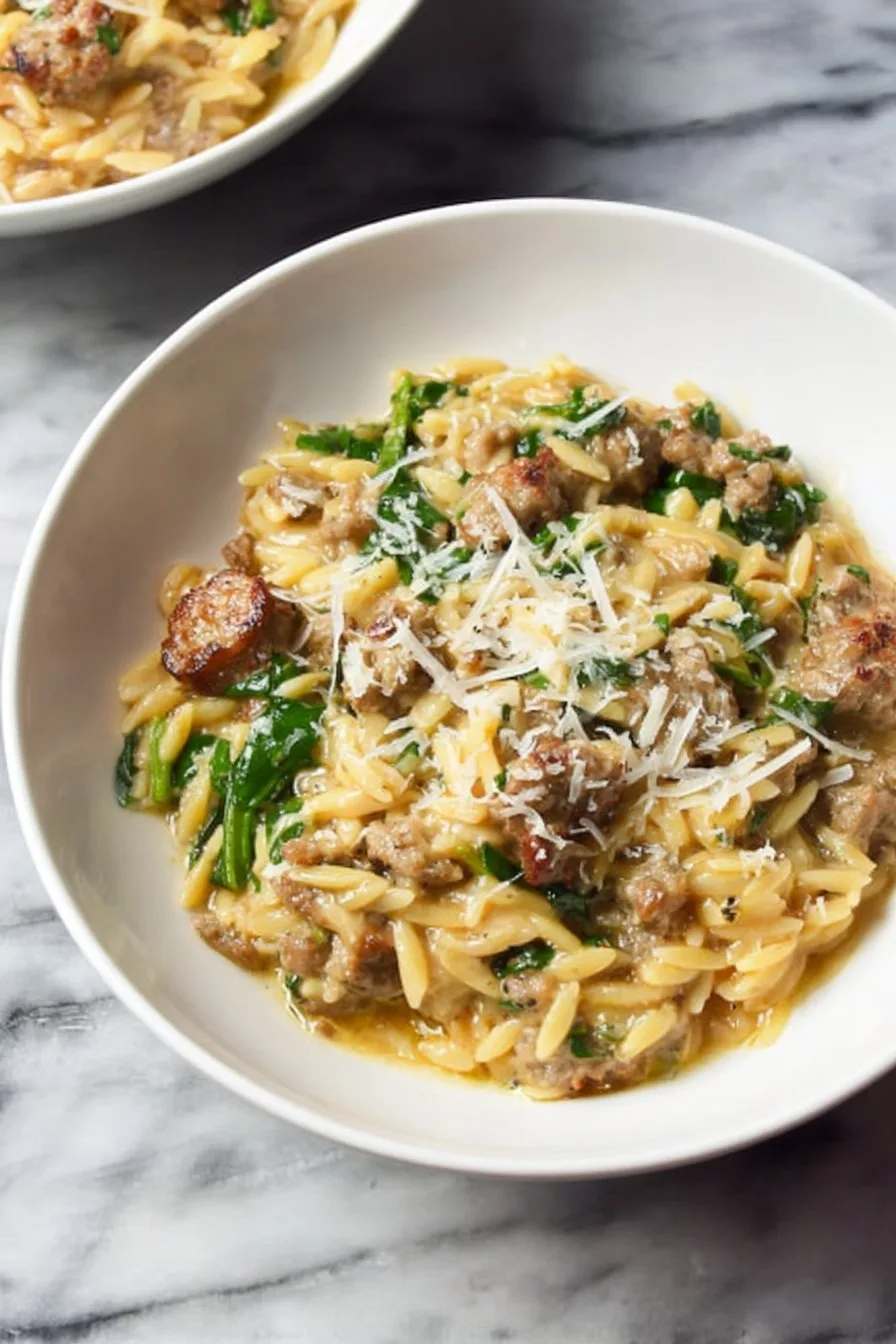
How To Store (If You Have Leftovers!)
Stick leftovers in an airtight container in the fridge. Should last 2-3 days, but honestly? In my house, it never lasts that long. If it firms up too much, add a splash of water or broth before reheating and give it a good stir.
How I Usually Serve It Up
I like it straight from the pot, but if my parents are around, I’ll add a bit more cheese and maybe a drizzle of olive oil. Sometimes a little side salad (like this one) makes me feel like I’ve got it all together.
Pro Tips (Learned the Hard Way…)
- I once tried rushing the simmering step and ended up with crunchy orzo. Not recommended—just let it do its thing.
- Actually, I find it works better if you let it sit for a couple minutes off the heat before serving. The orzo soaks up even more flavor (and it won’t burn your tongue).
- Don’t be shy with the cheese. There is no such thing as too much Parmesan, as far as I’m concerned.
Questions I Get All The Time
- Can I make this ahead? Yep! It reheats pretty well, though you might need to add a splash of broth. The flavors deepen, which I sort of love.
- Is it spicy? Only if you use hot sausage or chili flakes (which I do about half the time, because why not?).
- Vegetarian options? Skip the sausage, add canned chickpeas and extra herbs. My friend tried it with Beyond Sausage and said it was actually good, so there you go.
- What’s a good side? Garlic bread, obviously. Or a simple salad. Or, you know, just a glass of wine and put your feet up. (This garlic bread recipe is a personal favorite.)
- Can you freeze it? You can, but I think it gets a bit mushy when defrosted. If that doesn’t bother you, go for it.
Anyway, hope you give this Italian Sausage Orzo a go. If you do, let me know how it turns out. Or if you end up with more leftovers than you bargained for, drop by—I’ll bring the wine!
Ingredients
- 1 lb Italian sausage (mild or spicy), casings removed
- 1 cup uncooked orzo pasta
- 1 tablespoon olive oil
- 1 small onion, diced
- 2 cloves garlic, minced
- 1 red bell pepper, diced
- 1 can (14.5 oz) diced tomatoes
- 2 cups chicken broth
- 1 teaspoon dried Italian herbs
- Salt and black pepper to taste
- 1/4 cup grated Parmesan cheese
- Fresh basil, chopped (for garnish)
Instructions
-
1Heat olive oil in a large skillet over medium heat. Add the Italian sausage and cook, breaking it up with a spoon, until browned and cooked through, about 5-6 minutes.
-
2Add the diced onion, garlic, and red bell pepper to the skillet. Sauté for 3-4 minutes until the vegetables are softened.
-
3Stir in the uncooked orzo, diced tomatoes (with juices), chicken broth, and dried Italian herbs. Season with salt and black pepper.
-
4Bring the mixture to a boil, then reduce heat to a simmer. Cover and cook for 10-12 minutes, stirring occasionally, until the orzo is tender and most of the liquid is absorbed.
-
5Remove from heat. Stir in grated Parmesan cheese. Garnish with fresh basil before serving.
Approximate Information for One Serving
Nutrition Disclaimers
Number of total servings shown is approximate. Actual number of servings will depend on your preferred portion sizes.
Nutritional values shown are general guidelines and reflect information for 1 serving using the ingredients listed, not including any optional ingredients. Actual macros may vary slightly depending on specific brands and types of ingredients used.
To determine the weight of one serving, prepare the recipe as instructed. Weigh the finished recipe, then divide the weight of the finished recipe (not including the weight of the container the food is in) by the desired number of servings. Result will be the weight of one serving.
Did you make this recipe?
Please consider Pinning it!!

